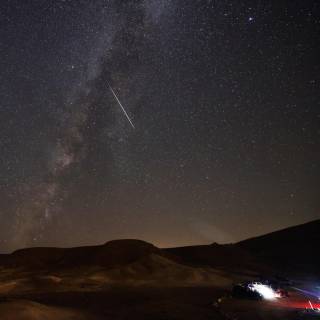Scientists have watched the final moments of a star after it was torn to shreds by a previously unknown black hole.
The star’s death was revealed to astronomers who saw a bright flare of radiation that was brighter than the whole of its home galaxy.
Researchers say the discovery has already led to “widespread excitement” and could help not only find such black holes but also tell them more about their size.
Before the discovery, the intermediate-mass black hole was lurking unfound in a quiet dwarf galaxy 850 million light years from Earth. But it was discovered when a star strayed too close the black hole, creating a “tidal disruption event” or TDE that produced a bright flare that shone through the universe.
That flare was picked up by scientists working on the Young Supernova Experiment, or YSE. That was designed to spot exactly those kinds of cosmic explosions and brief astrophysical eruptions.
They describe their findings in a new paper, ‘A fast-rising tidal disruption event from a candidate intermediate-mass black hole’, published in Nature Astronomy.
“This discovery has created widespread excitement because we can use tidal disruption events not only to find more intermediate-mass black holes in quiet dwarf galaxies, but also to measure their masses,” said coauthor Ryan Foley, an assistant professor of astronomy and astrophysics at UC Santa Cruz.
The findings not only show the existence of that newly found black hole. They will also allow us to find out more about other middling black holes, researchers said.
“The fact that we were able to capture this midsize black hole whilst it devoured a star offered us a remarkable opportunity to detect what otherwise would have been hidden from us,” said Charlotte Angus, from the Niels Bohr Institute, who is the first author on the new paper.
“What is more, we can use the properties of the flare itself to better understand this elusive group of middle-weight black holes, which could account for the majority of black holes in the centres of galaxies.”
All massive galaxies, including ours,have supermassive black holes at their heart. But scientists think those vast black holes – which can be billions of times the mass of our Sun – might once have been smaller intermediate-mass black holes.
Scientists think they might have grown as smaller dwarf galaxies, with equally small black holes, merged and stuck together. As they did so, their galaxies and the black holes within them might have grown, eventually enough to form the supermassive black holes that we can see today.
Scientists hope that finding more of these elusive intermediate-mass black holes could allow us to build a picture of how many there are around, and where they are. That in turn could help tell us both how supermassive black holes form and whether they might be at the heart of all dwarf galaxies.
Until now, however, finding those intermediate black holes has proven difficult because our equipment is not sensitive enough to pick up such small signals. The latest study overcome that by picking up the very first signs of light as the black holes’ feast began – and using that data to work out the mass of the black hole.
Read MoreElon Musk urges ‘independent-minded’ followers to vote Republican in midterms
Alma radio telescope in Chile taken down by cyber attack
X-ray vision reveals matter doomed to become a black hole’s meal, scientists say
History Channel divers found piece of exploded space shuttle Challenger, Nasa says
Section of Challenger space shuttle found on ocean floor
What does Nasa stand for? What you should know about the space agency
